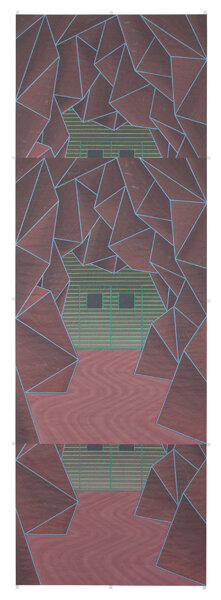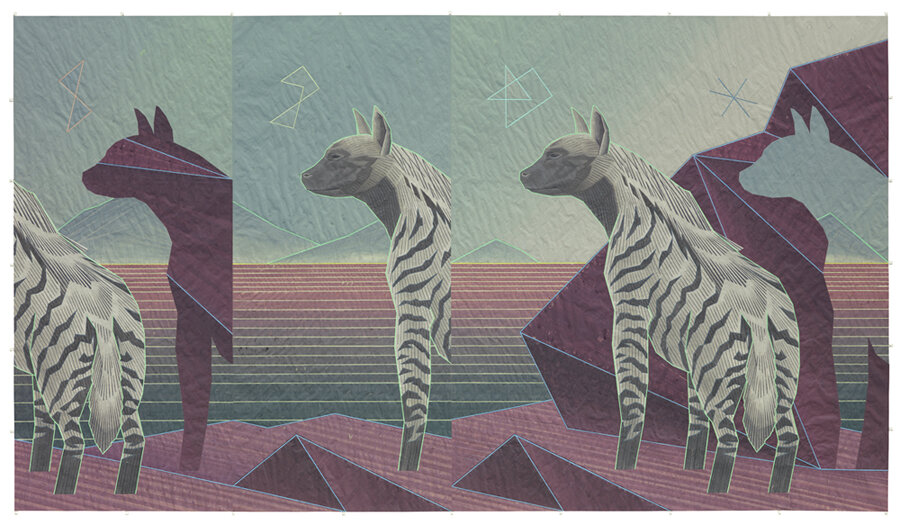
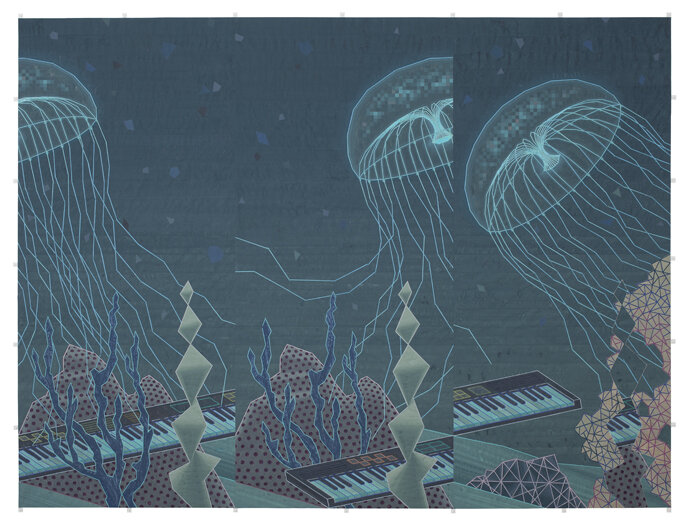
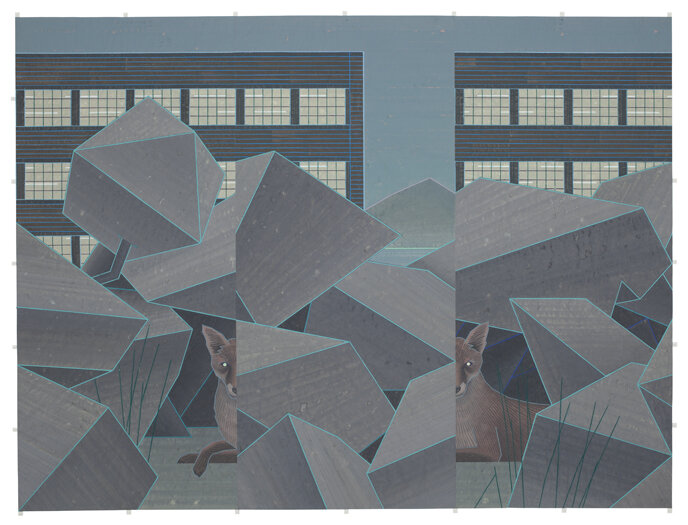
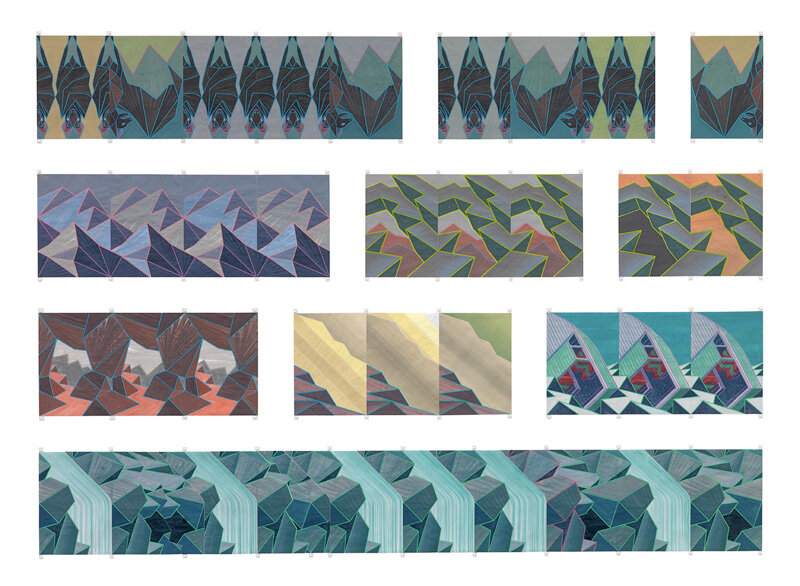

PARIS
John Hodany
March 24 - May 5, 2012
John Hodany’s work cannot easily be defined. Over the last dozen or so years it has developed in a way that owes nothing to fantasy and everything to the rigor of a personal logic that places him at a crossroads between the man of art and the man of science. Each of his exhibitions marks a stage in the pursuit of a "critical theory of evolution" whose neo-Darwinian principles lead to non-Euclidian applications. His subjects are disconcerting, his techniques almost inconceivably subtle. He creates images that are sometimes redolent of cartoons or animations, on paper, scrolling past like screens but also suggesting the universe of the Japanese print, though much larger. In this exhibition there are works of great scope, in every way.
As a director (in the cinematographic sense of the word), or rather a designer of spaces placed under the sign of the "4th dimension", Hodany slows down time to the point of immobility. But what this gives rise to is a form of simultaneous disintegration that might be termed "fractal division", using glue, paper, some color and scissors. One has a vague idea that this division could be transmitted by the effect of a mysterious, irreversible cascade that sets off a phenomenal storm, and adds its own seismic effects to that of continental drift. Hodany uses a distinctive approach that combines the techniques of painting – and his particular tactile sensibility – with a process of computer-type "copy and paste" embedding in which the principle of segmentation, starting with source figures, leads by subtraction to the creation of others that are identical. Rocks, animals and other objects pass through the "motif" phase. Hodany cuts into the painted surface, and carefully transports the resulting fragments to new locations, so that in disappearing, then reappearing in the same composition, the figures produce the illusion of having been displaced.
The images contain blocks with steely edges at a world’s end : fragments of ice cap or volcanic rocks, if one insists on identifying them, except that they appear to be nothing less than natural, and could just as easily be termed "technological residues". In this way Hodany invents landscapes whose only inhabitants are animals chosen among those that might be thought most resistant to catastrophe – the fox, the weasel, the seal and the hyena – in a strange menagerie that posits as self-evident the absence of people, or their imminent disappearance.
-Bernard Zürcher
John Hodany (b. 1974, New York) lives and works in Berlin and New York. In 2002 he received an MFA from Ateliers 63 in Amsterdam, and a BFA from Cooper Union in New York.
Solo exhibitions : 2012, Marking Territory, Nationalmuseum, Berlin ; Venus, Clussler, Berlin, 2010 ; Habitat Interchange, Zürcher Studio, New York ; Holy Rollers, Galerie Lena Brüning, Berlin.
Group exhibitions : 2012, Back from LA, Zürcher Studio, New York ; The round quadrango, Ballhaus Ost, Berlin, 2011 ; Drawing Now Paris 2011, Galerie Zürcher, Paris ; The Raising of Lazarus, Nationalmuseum, Berlin ; The round quadrango, Ballhaus Ost, Berlin ; 2010, Group Show compiled by Sebastian Dacey, Galerie Sabine Knust, Munich ; Paranoia, Cacaofabriek, Helmond (Netherlands) ; Das Gerücht, Galerie Conradi, Hamburg ; 2009, Wild Feature, curated by Brian Belott at Zürcher Studio, New York, and Galerie Zürcher, Paris ; 2008, Precurse, curated by John Hodany, Nationalmuseum, Berlin ; They Told the Future Backwards, Nationalmuseum, Berlin ; Caetano de Almeida, John Hodany, Michael Lazarus, Eleven Rivington Gallery, New York.
Public collections : Museum of Modern Art, New York.
L’Oeuvre de John Hodany ne se laisse pas aisément définir et connaît depuis une dizaine d’années un développement qui ne doit rien à la fantaisie mais à la rigueur d’une logique personnelle qui place l’artiste à la jonction entre l’homme de l’art et l’homme de science. Chacune de ses expositions marque ainsi une étape sous la conduite d’une « théorie critique de l’évolution » dont les principes néo-darwiniens le conduisent à des applications non-euclidiennes. Les sujets déconcertent, les techniques employées sont d’une subtilité quasiment insaisissable. Il crée des images qui s’apparentent parfois au cartoon, au dessin animé, sur de grands supports papiers qui se déroulent comme des écrans, mais qui ne sont pas sans évoquer également l’univers des estampes japonaises, en beaucoup plus grand. Il y a dans cette exposition des œuvres de grande envergure – à tous les sens du mot.
Réalisateur (au sens cinématographique), ou plutôt concepteur d’espaces placés sous le signe de la « 4e dimension », il parvient à ralentir le temps jusqu’à atteindre l’immobilité mais, parvenu à ce stade, il se produit alors une forme d’éclatement simultané, qu’on qualifiera de « division fractale », que l’artiste initie avec de la colle, du papier, un peu de couleur et des ciseaux. On sent confusément que cette division pourrait se transmettre, par l’effet de quelque mystérieuse et irréversible transmission en chaîne, jusqu’à enclencher un orage phénoménal en ajoutant ses propres effets sismiques à la dérive des continents. Hodany a recours à une méthode personnelle associant les moyens de la peinture – avec la sensibilité tactile qui lui est propre – à un processus d’incrustation (embedded) de type « copier coller » informatique où le principe de segmentation à partir de figures sources conduit par soustraction à en recréer de nouvelles à l’identique. Rochers, animaux ou tous autres objets passent ainsi par le stade du « motif ». Hodany coupe dans la surface peinte et transporte soigneusement ces fragments pour les refixer à de nouveaux emplacements de sorte qu’en disparaissant pour réapparaître au sein de la même composition, les figures donnent l’illusion de s’être déplacées.
Les images de John Hodany charrient des blocs aux arêtes acérées de fin du monde : morceaux de banquise ou rochers volcaniques si l’on veut absolument les identifier, sauf qu’ils apparaissent rien moins que naturels et pourraient tout aussi bien être désignés comme « résidus technologiques ». Hodany invente ainsi des paysages dont les seuls habitants sont quelques animaux choisis parmi ceux qui semblent pouvoir mieux résister aux catastrophes : renard, belette, phoque, hyène, forment une étrange ménagerie qui pose comme une évidence l’absence de l’homme ou le signe annonciateur de sa disparition.
-Bernard Zürcher
John Hodany (né en 1974, NY) vit et travaille à Berlin et à New York. Il reçoit en 2002 son M.F.A aux Ateliers 63 à Amsterdam (NL) et son B.F.A à la Cooper Union de New York.
Expositions personnelles : 2012, “Marking Territory” Nationalmuseum, Berlin, “Venus”, Clussler, Berlin 2010, Habitat Interchange”, Zürcher Studio, New York, USA.2009, “Holy Rollers” at Galerie Lena Bruening, Berlin
Expositions de groupe : 2012 ”Back From LA”, Zürcher Studio, NY, “The round quadrango”, Ballhaus Ost, Berlin 2011, Drawing Now Paris 2011, Galerie Zürcher, Paris, "The Raising of Lazarus", Nationalmuseum, Berlin, DE, “The round quadrango”, Ballhaus Ost, Berlin, DE ; 2010, Group Show compiled by Sebastian Dacey, Galerie Sabine Knust, Munich, DE, “Paranoia”, Cacaofabriek, Helmond, NL. “Das Gerücht”, Galerie Conradi, Hamburg, DE ; 2009, “Wild Feature” curated by Brian Belott at Zürcher Studio, NY/Galerie Zurcher, Paris, and in 2008, “Precurse” curated by John Hodany, Nationalmuseum, Berlin, “They Told the Future Backwards” Nationalmuseum, Berlin, and, “Caetano de Almeida, John Hodany, Michael Lazarus” Eleven Rivington Gallery, New York.
Collections publiques : Museum of Modern Art, NY

